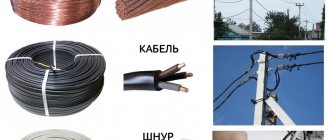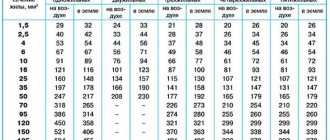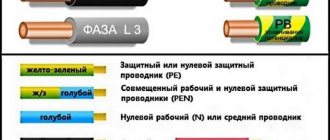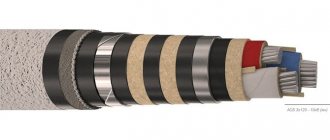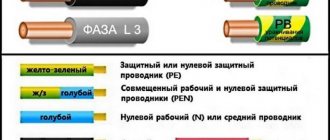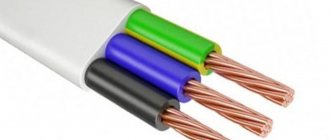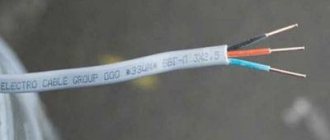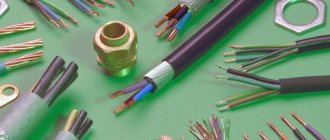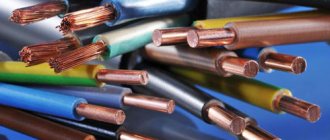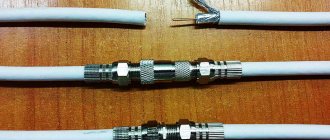To ensure uninterrupted operation of electrical equipment during various types of household, construction and repair work, it is necessary to ensure high-quality transmission of electricity over a distance. The easiest and most reliable way to do this is to make a special carrier. Let's look at what parameters an extension cable should have, what brands of conductor are most often used, what rules are used to select it for specific application conditions, and how to correctly calculate the possible power loss.
Cable for making an extension cord with PVC sheath Source prom.st
Popular cable brands - features, characteristics, application
For everyday use at home, the carrying cable must first of all have good flexibility, be resistant to low temperatures and frequent kinks. The following most popular range of conductor brands has similar characteristics:
- KG.
The marking abbreviation means flexible cable. Has a rubber electrical insulating shell. Performance characteristics:
- Operating temperature range – from -40 to +50°C.
- Number of bending cycles – 30 thousand.
- Service life – 4 years.
Designed for outdoor use. Compressive and bending loads are allowed. Exposure to direct sunlight is not recommended. The 220V extension cable has an analogue from European manufacturers - XYMM.
- KG-HL.
An analogue of the above brand of cable, but capable of operation at lower temperatures – down to -60°C. A distinctive feature is the ability to maintain elasticity in severe frost with full preservation of electrical characteristics.
For outdoor use, a cable with rubber insulation of the KGHL brand is best suited Source korona42.ru
- KGN.
The conductor is intended for use in aggressive conditions - when the shell can be exposed to various chemicals, oils, sparks from electric welding, etc. Operating parameters:
- Temperature – from -30 to +50 °C.
- Service life – 2.5 years.
- Number of bending cycles – 30 thousand.
The cable is also not recommended for use in direct sunlight.
- PVS.
This brand provides an answer to the pressing question of which wire is best to choose when the extension cord is inevitably operated under direct scorching rays of the sun. However, the price for such an advantage is an inevitable decrease in resistance to temperature changes.
Therefore, PVA can be used no lower than -25 °C, and ideally only at above-zero ambient temperatures. Its service life is about 6 years, and the number of bending cycles is 30 thousand.
- PRS
Another conductor based on a polyvinyl chloride sheath. Its characteristics are similar to PVA. The exception is a more extended temperature regime - from -40 to +40 °C. At the same time, European manufacturers have an analogue of this brand - this is RN.
Cable structure with PVC sheath brand PRS Source n-kabel.ru
Note! The longer the extension cord, the greater the power loss. The disadvantage is compensated by choosing a conductor with a larger cross-sectional area.
See also: Catalog of companies that specialize in electrical work of any complexity
Determining the wire cross-section for an electric stove
So, the network in the house can be single-phase or three-phase. If you live in a new house, you can safely choose a wire for a three-phase network. You can also determine the type of wiring visually, just look at the wire that goes to the electric stove. If the cable has only three cores, the wiring is single-phase. If you see 5 wires, the network is three-phase.
The choice of wire for an electric stove also depends on whether the wiring is open or closed. The table shows cable cross-section values for different materials and different types of wiring.
Table of cable cross-section depending on the type of wiring
| Cable cross-section, mm² | Wiring with copper core | Wiring with aluminum core | ||||
| Current, A | Power, kW for single-phase network | Power, kW with three-phase network | Current, A | Power, kW for single-phase network | Power, kW with three-phase network | |
| 0,5 | 11 | 2,4 | – | – | – | – |
| 0,75 | 15 | 3,3 | – | – | – | – |
| 1,0 | 17 | 3,7 | 6,4 | – | – | – |
| 1,5 | 23 | 5,0 | 8,7 | – | – | – |
| 2,0 | 26 | 5,7 | 9,8 | 21 | 4,6 | 7,9 |
| 2,5 | 30 | 6,6 | 11,0 | 24 | 5,2 | 9,1 |
| 4,0 | 41 | 9,0 | 15,0 | 32 | 7,0 | 12,0 |
| 6,0 | 50 | 11,0 | 19,0 | 39 | 8,5 | 14,0 |
| 10,0 | 80 | 17,0 | 30,0 | 60 | 13,0 | 22,0 |
| 16,0 | 100 | 22,0 | 38,0 | 75 | 16,0 | 28,0 |
| 25,0 | 140 | 30,0 | 53,0 | 100 | 23,0 | 39,0 |
Criterias of choice
When selecting a conductor for carrying in specific application conditions, it is necessary to consider the following number of parameters:
- Length and number of sockets.
- Brand and cross-sectional area.
- Protection from damage.
- Plug type.
- Protection from power surges and external conditions.
Let's look at the features of each of them in more detail.
Length
Sometimes the consumer does not understand the essence of the laws of functioning of electrical conductors and tries to decide which cable to choose for a 220 V extension cord for 50 meters and further - in this way, hoping to provide power to the most remote corner of his home area. In practice, this results in a huge loss of power, overheating and even the possibility of insulation fire.
The optimal length of a household electrical extension cord is 5-10 meters Source yato-shop.pl
The reason for this is the neglect of the rules for calculating the cross-section of the conductor in terms of its length. Therefore, in order to avoid various kinds of troubles and dangers in operation with electrical wiring, it is recommended to limit the carrying length to a maximum of 10 m. This is especially true when powerful electrical appliances are connected to the network.
In any case, the maximum permissible load on an extension cord in everyday life is limited to 3.5 kW or 16 A, respectively. At the same time, it will not be possible to increase the load by increasing the thickness of the conductor due to the limited endurance of the contacts in the outlet itself.
Recommendation! The number of sockets on the carrier can be 3, 5 or more. However, this does not mean that all of them can be connected at the same time. This was done primarily in order to protect the sockets from loosening when it is necessary to frequently switch different devices.
Brand and cross-sectional area
When choosing a conductor based on cross-sectional area, you must be guided by the following load recommendations:
- No more than 1.3 kW or 6 A – from 0.75 mm².
- Up to 2 - 2.5 kW or 10 A - at least 1-1.5 mm².
- Up to 3.5 kW or 16 A – 2.5 mm².
The most commonly used brands are PVS. However, if you need to use a carrier outdoors, in a garage or on a concrete or cluttered floor, it is better to give preference to the KG. Since the material of its shell is more resistant to destructive factors.
The best power extension cords for one outlet
Power extension cords for one outlet will be an excellent solution if you have your own household: you can connect a saw, a jigsaw or a lawn mower one at a time.
1st place – power extension cord LUX YC1-E-10 (Y-161)
This power extension cord will be the best option for individual repair work on a small scale: the PVA wire is not afraid of bends and large loads that may accidentally end up on it, and the length of 10 meters will allow you to carry out work in the yard without any difficulties or inconveniences. The socket is completely safe thanks to the rubberized body; it is not afraid of high humidity.
Maximum power – 2200 W.
Cable cross-section – 3x0.75.
The average price is 550 rubles.
Advantages:
- Affordable price;
- Wire with grounding;
- Bright cable color, visible from afar;
- Rubberized socket.
Flaws:
- Low power for a power extension cord;
- Cable length is only 10 m;
- Before work, be sure to unwind the wire completely.
Calculation of power loss
In order to understand which wire to make an extension cord for the street from, you need to take into account the following number of parameters:
- Conductor material.
- The power of the consumer and the cross-sectional area depending on it.
- Carrying length.
With this data, you can determine power loss and risk factors for each specific extension cord. Let's look at an example calculation for a copper wire 5 m long and a cross-sectional area of 1.5 mm² using the following algorithm:
- Each meter of copper conductor has a resistance of about 0.01 ohms.
- When calculating, double the cable length (phase + zero) is taken - that is, 10 m.
- Thus, the total carrying resistance = 10 * 0.01 = 0.1 Ohm.
- When a current of 10 A is applied, the voltage drop = 10 * 0.1 = 1 V.
- In this case, the heating power of the conductor = 10 A * 1 V = 10 W.
When the carrying length increases to 10 meters, its value will increase to 20 W, and to 20 m - 40 W, etc. For an aluminum conductor, the heating value will be 1.5 times higher, which may already be sufficient to ignite the insulation. Therefore, it is extremely important to choose the right wire according to the material and the planned carrying length, and not just based on its cross-sectional area.
DIY extension cord: things to remember
An electrical extension cord or carrier is present in every home and office.
The need for this simple electrical device arises when you need to connect electrical equipment in the absence of a permanent outlet or a power tool in a hard-to-reach place. Assembly instructions:
You can purchase a ready-made extension cord. But it’s safer and cheaper to make it yourself.
If you have the components and skills to work with the tool, the process will take 20 minutes. You will need: a collapsible plug, a wire of the required length and a block of sockets.
The insulation of the grounding conductor is yellow-green. It is important to connect it correctly to the appropriate terminals. To use the product safely you must:
- Availability of grounding. Therefore, we choose a three-core cable, and the plug and sockets have grounding terminals.
- Availability of an appropriate degree of protection for sockets. For example, a design for the street and a bathroom should be waterproof, with a hinged lid. A surge protector is used in carrying computer equipment. External type sockets cannot be used; the rear wall must be closed. It is recommended to connect a block of sockets consisting of at least three pieces
In the store you can buy a ready-made block for assembling extension cords.
- Correspondence of the wire brand to the operating conditions, and the cross-sectional area to the power (current) of the load.
Assembly order:
- Strip the ends of the cable of insulation by 4-6 centimeters, and each core by 10 millimeters, carefully without damaging it.
- Disassemble and connect the plug on one side, the sockets on the other. Inside there are special terminals for the cable.
- Check the extension cord with a multimeter.
- Tighten the screws and complete assembly.
When connecting the wire and plug, the insulation must be pressed tightly with a special clamp. Otherwise, when the cord is pulled out of the outlet, the load will regularly fall on the contacts. They will quickly weaken and begin to heat up.
To increase the reliability of the extension cord, you can make it with a switch in the form of a button.
If the carrying wire is long, for example 20 meters, it should be wound on a special reel, which you can also make with your own hands.
Briefly about the main thing
Most often, for the manufacture of street extension cords, rubber-insulated conductors KG and its European analogue XYMM, KG-HL, KGN and cables with a polyvinyl chloride sheath PVA and PRS are used. Each of them has its own operating characteristics and recommendations for use.
When choosing a carrier, the following number of parameters are taken into account:
- Length and number of sockets.
- Brand, conductor cross-section.
- Protection from destruction.
- Fork modification.
- Resistance to external conditions and network fluctuations.
When selecting a conductor for the manufacture of an extension cord, it is necessary to determine its power loss and the risk factor for the sheath fire from possible heating.
Electrical parameters and ratings of circuit breakers
As we found out, there should be separate RCDs and a circuit breaker in the electrical panel. Through them the phase is supplied to the socket. This pair can be replaced with a difavtomat. These are the same two devices, but in one case. The negative is taken from the common bus, passes through the RCD, and the grounding is taken from the corresponding bus.
The rating of the machine is selected based on the maximum current consumption. This data is in the electric stove's passport and is usually in the range of 40-50 A. In this range, the ratings come in large increments - 40 A, 50 A, 63 A. It is better to choose the nearest larger one - this way there is less chance of a false shutdown when operating at full power . That is, if the declared maximum current consumption is 42-43 A, still take a 50 A machine.
Electric stove connection diagram
On the other hand, you may never turn on all the burners and oven, and even at full power, and more powerful machines are significantly more expensive. It's up to you to choose.
The rating of the RCD is taken one step higher than that of the machine. If you decide to install a 50 A machine, then the RCD is required at 63 A, the leakage current is 30 mA.
